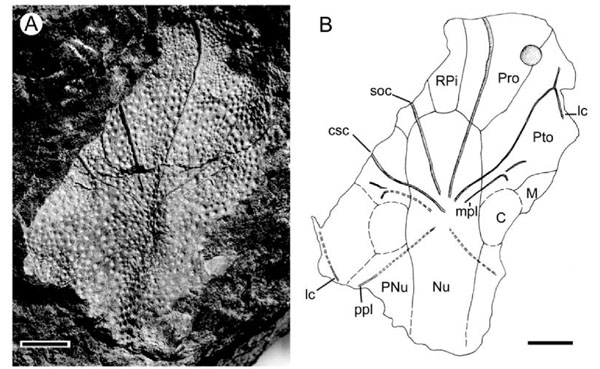Dr. Min Zhu, Key Laboratory of Evolutionary Systematics of Vertebrates, Institute of Vertebrate Paleontology and Paleoanthropology, Chinese Academy of Sciences, and his collaborators described a new genus and species of the Antarctaspidae (Placodermi: Arthrodira) -Potangaspis parvoculatus, from the early Emsian (Yukiang Formation, Early Devonian) of Pingguo, Guangxi, China, as recently reported in in the 2nd issue of Vertebrata PalAsiatica, 2010.
The specimen is the external mould of an incomplete skull roof, which preserved anterior and posterior extremities but lost the majority of lateral margins. This new form is characterized by small orbits enclosed by skull roof, and long, narrow nuchal plate on which the central and supraorbital sensory canals, middle and posterior pit-lines converge.

Fig.1: Photo (A) and illustrative drawing (B) of
Potangaspis parvoculatus, holotype, IVPP V 15050.1
Phylogenetic analysis corroborates the basal position of the family Antactaspidae amongst the Arthrodira, and suggests a sister group relationship between the new form and
Antarctaspis mcmurdoensis from the Middle Devonian of Antarctic. “The new genus of antarctaspids described here adds to the known diversity of the group in East Gondwana (Australia, New Zealand and Antarctica) and South China, and corroborates the biogeographic proximity between these two provinces during the early Emsian,” said Dr. Min Zhu.
It is noteworthy that, although the Antarctaspidae and the Wuttagoonaspidae are placed at the base of the Arthrodira, as successive sister groups to all other arthrodires including phyllolepids, they are not the earliest members of the Arthrodira. The study of closely related petalichthyids and earlier arthrodires such as Szelepis from the Lochkovian of South China and Eskimaspis from the Lochkovian of the Canadian Arctic Archipelago, will help to clarify the early radiation of the Arthrodira.
